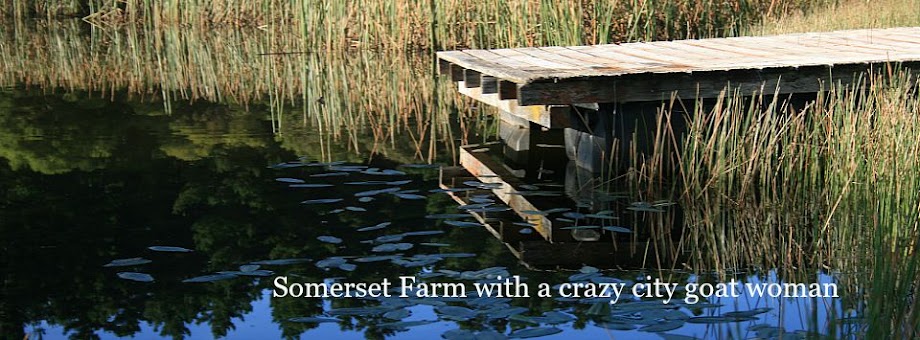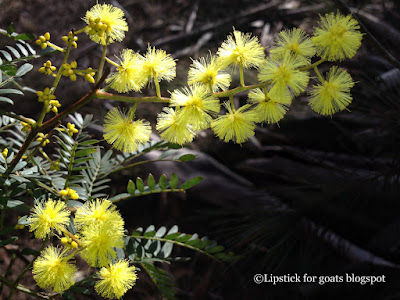I have always liked the look of neatly mown lawns but since
discovering the world of wildflowers here the thought of chopping their
beautiful heads off is abhorrent. My
driveway and along the verge of the road bordering our property are now looking
beautifully raggle taggle. My back yard would be the same but for snakes, we
must maintain the grass so we can see any slithery sliders who may casually
visit.
I have decided the goats will be never be allowed go into the
flower wonderland that is the heath area of our property. Such a turnaround for
me, I had considered this area as useless unproductive land ready to unleash
the goats on it.
Swamp Isotome (Isotoma fluviatilis)
Vanilla Glycine (Glycine tabacina)
White Flax Lily (Dianella)
Common Centaury (Centaurium erythraea)
It’s pink and pretty, all through our
grass in the driveway and paddock. Centaury is a herb, some of its uses is as a
tonic and antiseptic. A 10th
century poem by Macer mentioned it as being powerful against ‘wykked speryts’.
According to Nicholas Culpepper an English botanist, herbalist, physician, and astrologer of the 17th century
the herb is "wholesome but not toothsome" (being bitter). He reckons a
decoction of centaury dropped into the ears cleanses them of worms......
Centaury also takes away all freckles, spots and marks on the skin when being
washed with it. There you go; as a beauty therapist I spend a fortune on fancy creams when all I need do is
harvest my driveway!
Small St. John’s Wort (Hypericum gramineum) this is a native not
the weed
Sun Orchid (Thelymitra pauciflora)
Daphne Heath (Brachyloma daphnoides)
I only found two of these shrubs and
they had just about finished flowering. There are probably many more Daphne
Heath shrubs in our grassy woodland but as they weren’t in flower I wouldn’t
recognise them.
Grassland wood sorrel (Oxalis perennans)
Juniper leaf grevillea (Grevillea
juniperina)
Pale Grass Lily (Caesia Parviflora)
Many flowered mat-rush (Lomandra multiflora)
Scarlet Pimpernel (Anagallis
arvensis)
“No heart can think, no tongue can tell,
The virtues of the Pimpernel.”
Another herb being a
diuretic, expectorant, and the ancient Greeks used it for diseases of the
eyes. French women loved the distilled
Pimpernel to cleanse their skin from any roughness, deformity or
discolouration. Culpepper recommended it for bites of mad dogs and to dispel
sadness. Of course it also prevents witchcraft!
Leafy Bitter Pea (Daviesia mimosoides)
There are many ‘Peas’ flowering in
spring, they are very showy little plants ranging from orange and red,
yellow with red and this beautiful
salmon version.
Wattle mat-rush (Lomandra filiformis)
Purple Violet (Viola betonicifolia)
Gorgeous little violets found all
through our grassy woodland.
Shrubby rice flower (Pimelea linifolia)
Stinking pennywort (hydrocotyle laxiflora)
Found in the shade of trees or amongst rocks, they really do have a foul scent!
Found in the shade of trees or amongst rocks, they really do have a foul scent!
Mitre Weed flower (Mitrasacme polymorpha)
I really want to know why we have the word ‘weed’
in this one’s name, it is noted as a perennial herb. The photo doesn’t do it justice; it is really
pretty, whether as a single flower popping up or in a clump. The leaves grow at
the base of the plant. Buds start out as a beautiful salmon pink colour sitting
at the end of a long delicate stem,
opening to the white flower which is about the size of my little finger
nail.
Haresfoot Clover (Trifolium arvense)
Well I guess if I have to
have what is considered a weed – clover – it may as well be a pretty one. Funny
how in the city we consider all clover as weeds in our lawn but in the
paddocks some clovers are desirable as a soil building plant, nodules on the roots fix nitrogen in the soil.
Pale Everlasting (Helichrysum rutidolepis)
Melaleuca
Spiny headed Mat-rush ((Lomandra
longifolia)
Tiger Orchid (Diuris sulphurea)
Leaf Daisy ((Brachyscome rigidula)
Slender Bottle Daisy (Lagenophora
gracilis)
Photos are deceiving! This daisy is so
tiny, being smaller than my little finger nail.
Austral Hounds Tongue (Cynoglossum
australe)
Think this one might be a problem. The description says it has tiny hooks that
attach to clothing therefore gets spread.
Just as well I only found a few plants in one spot where we had a burn
off fire. I will be revisiting to pull them out.
Clustered Everlasting (Chryscephalum
semipapappoeum)
Clusters of 20 flowers or more with a
flattened top at the end of erect stems. I think rabbits like eating these, I
went back to take another photo when the flower heads had opened but they had
been chomped off and just the stalk remained.
Common Beard Heath (Leucopogon
virgatus)
This flower is so tiny three or four of
them would fit on my little finger nail!! The flower petals are surrounded by a fringe.
Common Everlasting (Chrysocephalum
apiculatum)
Sisyrinchium iridifoium
Cream and the larger white version, they
appear to be considered a grassland weed. I keep using the analogy of my little
finger nail for size comparison, again three of the cream ones would fit my
small nail; the white version is much larger.
No idea!
Again I don’t know the name of this one
found in the heath area.
Prickly Tee Tree (Leptospermum continentale
?)
Name Please! Tiny mauve/blue flowers
found in the heath area.
No Idea no.2
The flower on the reeds on the dams
The white parts of the flower head look like crazed worms!
Bidgee Widgee (Acaena novae-zelandiae)
Starts off as a unusual flower but it
turns into a spiny burr weed, which can be widely dispersed by sticking to
animals coats and to clothing. I must
look at eradication methods for this one, it is all over a steep hill and I
sure don’t want burr weeds all over the farm.
Although I read it provides seed for Rosellas, which is probably how it
is spread in the first place.
Black Wattle Blossom (Acacia
mearnsii)
I haven't been able to identify this one. Must be a weed, or maybe a member of the
yarrow family, but I am tending towards ‘weed' as it is absolutely all over our
property. A tiny low growing mat.
Summer is now here so I now eagerly await what blooms the season may bring.








































































